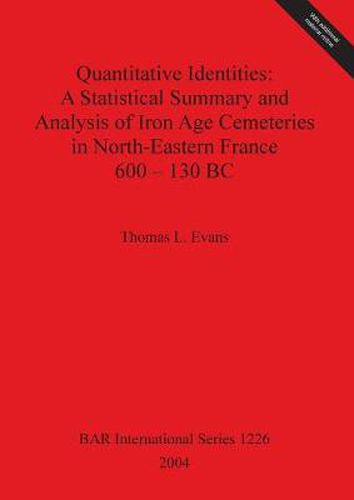Readings Newsletter
Become a Readings Member to make your shopping experience even easier.
Sign in or sign up for free!
You’re not far away from qualifying for FREE standard shipping within Australia
You’ve qualified for FREE standard shipping within Australia
The cart is loading…






This title is printed to order. This book may have been self-published. If so, we cannot guarantee the quality of the content. In the main most books will have gone through the editing process however some may not. We therefore suggest that you be aware of this before ordering this book. If in doubt check either the author or publisher’s details as we are unable to accept any returns unless they are faulty. Please contact us if you have any questions.
This work is an examination of the burial practices of the Upper Seine Basin during the earlier portions of the Iron Age (Hallstatt Finale to the La Tene Moyenne) conducted with the specific aims of examining concepts of identity as reflected through the funerary remains. It focusses upon three aspects of identity: regionality, gender and social status. These theoretical concepts are examined through the analysis of the artefact assemblage and the examination of aspects of similarity and differences in the artefact placement within the graves context. In order to examine these aspects, this work begins by reexamining the existing theories and models of understandings for the Iron Age in Northeastern France. It examines specifically the socio-economic models utilised to examine the general archaeological remains, the present understandings of social status, and pays particular attention to the existing models for our understanding of gender during the time period. Once the strengths and weaknesses of these approaches have been presented, the study goes on to discuss the analysis conducted by the author of a sample of archaeological sites. This analysis utilised a variety of quantitative techniques in order to obtain new data regarding aspects of identity associated with regionality, gender and social status. Among the statistical methods used were a simple comparison of mean averages for a series of burial categories identified by the author, as well as the use of the exploratory multivariate technique of correspondence analysis. The results are presented and discussed in detail, and then interpreted in the light of past and present models of our understanding of the Iron Age. Finally, the thesis discusses the nature of the changes in the burial rites between the Hallstatt Finale and the La Tene Moyenne, and presents a series of new interpretations of Iron Age culture in the region.
$9.00 standard shipping within Australia
FREE standard shipping within Australia for orders over $100.00
Express & International shipping calculated at checkout
This title is printed to order. This book may have been self-published. If so, we cannot guarantee the quality of the content. In the main most books will have gone through the editing process however some may not. We therefore suggest that you be aware of this before ordering this book. If in doubt check either the author or publisher’s details as we are unable to accept any returns unless they are faulty. Please contact us if you have any questions.
This work is an examination of the burial practices of the Upper Seine Basin during the earlier portions of the Iron Age (Hallstatt Finale to the La Tene Moyenne) conducted with the specific aims of examining concepts of identity as reflected through the funerary remains. It focusses upon three aspects of identity: regionality, gender and social status. These theoretical concepts are examined through the analysis of the artefact assemblage and the examination of aspects of similarity and differences in the artefact placement within the graves context. In order to examine these aspects, this work begins by reexamining the existing theories and models of understandings for the Iron Age in Northeastern France. It examines specifically the socio-economic models utilised to examine the general archaeological remains, the present understandings of social status, and pays particular attention to the existing models for our understanding of gender during the time period. Once the strengths and weaknesses of these approaches have been presented, the study goes on to discuss the analysis conducted by the author of a sample of archaeological sites. This analysis utilised a variety of quantitative techniques in order to obtain new data regarding aspects of identity associated with regionality, gender and social status. Among the statistical methods used were a simple comparison of mean averages for a series of burial categories identified by the author, as well as the use of the exploratory multivariate technique of correspondence analysis. The results are presented and discussed in detail, and then interpreted in the light of past and present models of our understanding of the Iron Age. Finally, the thesis discusses the nature of the changes in the burial rites between the Hallstatt Finale and the La Tene Moyenne, and presents a series of new interpretations of Iron Age culture in the region.